Features of military plan drawn up by the command of the international coalition and oversaw on its implementation with the Iraqi military and security forces began to be clarified in the nature of the events and actions taken place on the main axes of the command of Nineveh operations and after the announcement of these formations for the starting of the second phase on 29 December 2016 and taking the required and field procedures to speed up the operation of cleansing and control of all the residential neighborhoods on the left coast of the city of Mosul after they were stumbled for many reasons represented by the size of the sacrifices made by the attacking troops across the eastern axis and the nature of the defenses and interfaces adopted by the elements of Daesh in facing the attacking force through many of the pictures that were represented by the first fire lines, and car bomb and motorcycle , and after that the confrontation by medium and light weapons, and the population density of civilians and the nature of the close construction of houses and subways and main streets that impede the progress of military units, ambushes and fires packages and tunnels prepared by Daesh fighters and snipers stationed on the roofs of high-rise buildings and some residential buildings overlooking the Public and the main streets of the city.
Hence, we can read the new features of the second phase, which were represented as follows:
1.Support the effectiveness and activity of the northern axis, which stationed throughout the past two months in the waterfalls area(Shalalat area), specifically near the Abbasid hill and was able to control the axis of Sada and Baoizh which is considered the front face to enter the residential neighborhoods located and extending into the northern axis, and for this we saw that the fighters of the division 16 and guard of Nineveh were able to advance effectively and backed by US and French artillery that its range of up to 45 km towards the control of the first neighborhoods which is the Hadba neighborhood where the security formations of the force were managed to tighten its control over the northern edge of the neighborhood Hadba of residential apartments in which to extend its influence in the Cairo neighborhood as it seeks to comb and cleanse these neighborhoods to complete its tasks by the completion of the neighborhood of Hadba and advance towards the Arab neighborhood.
- The obvious field picture was completed of the activities of the ninth armored division and with the participation of the Federal Police fighters in the southern and the eastern sector and they managed by continuous air support from the command of the international coalition and the Iraqi air force and with the participation of bombers (B-52) and the F-16 in supporting and enhancing the progress done by the formations of the Federal Police and its full control of the neighborhoods (Intisar- judaydat al mufti -sbaawi) and tightening of its influence in the neighborhoods (Methaq- al-wahda- al-Ataba -Baath) with continued fighting and fighting to regain control on al-Salm hospital and in order that the forces to continue its march toward the bank of the Tigris River.
3.Support the east axis, which is one of the main axes that had a main role in the process of achieving progress toward many of the neighborhoods of the left Sahel region, especially after the control and entry to the area of Alecoqgele.
And the second stage in this axis was marked to the rearrangement and the structure of anti-terrorism forces and its capability to control the neighborhoods ( al-Quds- al-Karamah-industry Muthanna-al-Rifaq) These achievements put these forces in a large and intense clashes marked the stages of entry to these neighborhoods because of the intensity of defenses and field supports of Daesh fighters who pulled out from the neighborhoods mentioned by aerial and artillery bombardment fire from coalition aircrafts and US artillery.
The field commanders of this axis are seeking of intensifying its activities to be parallel with what was started by the south-east axis of access to the bank of the Tigris River and the confluence of the two axes at the intersection of Third and fourth bridge.
4.The basic obvious characteristic is the field deployment of American advisers and increase their effectiveness in enabling the security and military forces to carry out the stages of the plan, which placed tightly ,and this is the second phase of the attack within the main four axes surrounding the city of Mosul ,and these forces were backed by formations of US forces of engineering and intelligence experience and supplemented with fighters from the units of US special forces that formed a strategic and ground depth managed through it to the promotion of progress and support in clearing several residential neighborhoods in the area of the left Sahel and the US squads are becoming the supportive and directive to the progress of the Iraqi units.
- Because of the escalation of military operations and increase the effectiveness of aerial and artillery bombardment , the proportion of victims and martyrs among the local population of the city of Mosul have been increased as a result of the fall of mortars by the attacking forces and defending adding to the aerial and artillery bombardment of the planes of the international coalition which led to the high number of the displaced people by 155 thousand of the displaced people and those lacking the most basic decent living requirements due to the failure of the Ministries of Commerce, Health and Displacement and migration to provide what the displaced families need from food supplies, blankets, fuel and medical supplies to help them as they are in it .
The unity of the Iraqi Studies
Translated By Mudhaffar Al-Kusairi
Rawabet Center for Research and Strategic Studies

